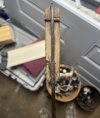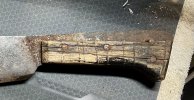GB940Rookie
Gold Member
- Joined
- Apr 19, 2016
- Messages
- 3,385
I am at an antique store. Has anyone ever seen one of these? Know what it is?View attachment 2534641
Thank you. With new scales it should make a good camping knife.
Would you put arms on the Venus de Milo so she'd be a good hallway decoration? Just asking....Thank you. With new scales it should make a good camping knife.

Great information. Mine has the tapered tang and the four pins seem to be steel, not brass.Second half -
The Intrenching Machete, as discussed above, shared the original scabbard for the Hospital Corps Knife. From an outward appearance the scabbard looks to follow the design of the Model 1910 bolo scabbard. This is strictly an illusion as the two are very different. The canvas cover is riveted in place and not removable like the 1910. More importantly the materials used are vastly different. The scabbard is formed from a piece of paper fiberboard folded in a triangular fashion, covered in cloth duck and seam covered in leather. A pleasant looking scabbard and light in weight but not at all durable. The knives and machetes survived the abuse of wear and tear but few of the original scabbards did. The heavy leather sheath for this knife was just as heavy duty and durable as the knife. The throat is made of brass and riveted on. The M1910 double hook is attached to the body by a billet that is sewn and riveted to a reinforcing piece which is then sewn to the sheath body. This hangar setup attachment is identical to the M1939 leather machete scabbards also manufactured by Boyt. The Boyt Harness Company manufactured it in several variations if you count markings as differences. Those of you wanting an example of every type will no doubt love the dating of the scabbards. Be on the lookout as the orientation of the stamping could also be off 90 degrees! Another variation for those of you counting. Ironically the only other difference was the number of rivets found on the blackened brass throat of the sheath, aside from that and the markings they are virtually identical. The earliest pattern had two attaching rivets on either side of the throat while the later pattern had an added third rivet in the center of the throat to keep it in contact with the leather. You can see on the early pattern sheaths that the leather would sometimes fold and not allow the knife to be inserted, the additional rivet solved that problem, just like it did on the Model 1872 Intrenching Tool scabbards. Scrimping on one rivet per side... The scabbards were all marked on the back with Boyt and the date of manufacture, 42, 43, 44, or 45. The 42-manufactured piece did not have the USMC over Boyt marking, but did have “US / Boyt / 42.” Why the Marines didn’t catch that earlier is a mystery. It is rare that you find a Marine Corps specified implement that is not USMC marked. In 1942 alone, the Marine Corps ordered 83,650 sheaths from Boyt at a cost of $1.30 each.
In December 1942, the Hospital Corps Knife was reviewed by the Marine Corps due to the adoption of the then new M1942 18" machete resulting in the cancellation of the Hospital Corps Knife contracts. In a letter from the Marine Corps to The Village Blacksmith, one of the manufacturers, it was asked to cancel two contracts amounting to 45,500 knives. The Marine Corps did state that other options could be arranged if the knives were made or steel and supplies were already secured. We also find a reply from John Chatillon & Sons dated December 1942 so we can conclude that all the Hospital Corps Knife manufacturers must have received the same cancellation letter from the Marine Corps. The reply stated:
Incidentally, we cooperated with your Department in revising the specifications on the Hospital Knife. At that time it was explained to us that the Hospital Knife was used as a general-purpose field tool for cutting splints, prying open boxes, even for driving nails. On the other hand, we understand the machete is more of a weapon and brush knife. The gauge of the machete is so light compared with that of the Hospital Knife that it would not be practical to use it for the same type of service that the Hospital Knife was originally made up for. We are wondering if this was considered.
It was a legitimate request, hell even a good one. A December 10 1942 follow up letter from the Marine Corps must have agreed as the request for cancellation was rescinded. The quickest cancellation reinstatement on record! The Hospital Corps Knife continued in production and in use for the remainder of the war. In fact it was again standard issue during the hostilities in Korea. The 1960 Landing Party Manual as issued by the Navy did not include the Hospital Corps Knife. While that is not an official indicator of status it does give us an indication of the use of various tools and weapons. The Hospital Corps Knife was not in the listing.
We could not extract the exact number of knives made from the existing records found but a fairly accurate count on remaining information places the number at above 200,000 made. With the numbers found today and the numbers we know were produced, Hospital Corps Knives were far outnumbering the Hospital Corpsmen. Various photos can be found of Marines wearing the Knife on the belts and backpacks as part of the “assaulting force infantry.” As the knife was issued as a part of the squad it stands to reason they often found favor with fighting men in the close quarter combat of the Pacific Islands. We also can find these knives in almost perfect condition today owing to the fact that so many were made they would naturally have been in storage, unused for years. This is the condition we like to find our collectibles in, crisp and unsharpened. Pick up a few, they make great conversation pieces when the conversation turns to uses.... such as amputation....
The author would like to thank fellow researchers Carter Rila and Alec Tulkoff for their efforts in helping to bring this information to print. We look forward to Alec’s soon to be in print book, ‘Grunt Gear’; knife aficionados will need to pick one up. A large Thank You to Larry Thomas for allowing access to photograph items in his collection. A true gentleman, always ready, willing and able to help.
All the best
Frank Trzaska
---------------------------------------------------------------------
I'll just add that maybe the use of Applewood scales might've came at the suggestion of the manufacturers or something looking at their catalogs early on. Applewood was long used by commercial kitchen cutlery makers for cleavers, butcher knives, etc.....
These are pretty popular with woodsmen that find them. I've seen them rehandled in micarta, etc.... Also common old and new mod was to clip the tip, turning them into Collins 18/Western W-49 style knives.
-----------------------------------------------------------------------
The Intrenching Machete also mentioned in the article -
.

Thought the same thing.That’s a pretty nice blank canvas for $22.
Here you go. Not much left of the handles. The wood structure is crumbling.personally, I'd remove the tape from the handle & see if the wood is worth cleaning up... if its still solid & mostly all there, I'd love to refurb it, sand it a bit & get some tung oil into it
great find for $22

